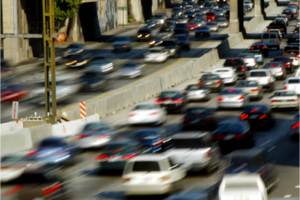Why Elon Musk wants to dig a tunnel under Los Angeles
Billionaire innovator Elon Musk says he's ready take the first steps on a plan to relieve L.A.'s traffic congestion by building a tunnel – near LAX.

Commuters take to the crowded LA freeways after work.
Robert Harbison/The Christian Science Monitor
Billionaire innovator and investor Elon Musk declared early Wednesday morning that he is digging tunnels under Los Angles to cut down on the city's legendary traffic.
While many saw his comments as a joke, with his entrepreneurial background in transportation-related projects and the new administration’s focus on infrastructure, Mr. Musk might actually have a chance.
The founder and CEO of space transportation company SpaceX and electric car maker Tesla Motors, Musk first mentioned his ambitious plans in December as he was stuck in traffic.
The cofounder of PayPal even thought a name for the company: Boring.
But his playful tweets turned more serious Wednesday, as he announced on Twitter that he plans to start building the tunnel right across from his desk at SpaceX in Crenshaw at Interstate 105, which is five minutes away from the Los Angles International Airport.
The declaration came as no surprise: Musk has been a strong proponent of tunnels for some years now. In an interview in 2015, he said he would prefer to build more car tunnels than to have flying cars.
"If you were to extrapolate that to cars, and have more car tunnels, then you would alleviate congestion completely. You would not need a flying car in that case," Musk said in Neil DeGrasse Tyson’s StarTalk radio show. "And it would always work, even if the weather is bad. It would never ice up, and it would never fall on your head.”
Musk's background in the transportation industry and as a tech visionary may also have inspired him. The Christian Science Monitor noted in December:
“Mr. Musk is no stranger to massive, transportation-related developments. He's already launched ambitious ventures aimed at pioneering space travel, colonizing Mars, revolutionizing electric cars, and designing a new high-speed rail system that would travel at upward of 700 miles per hour.”
The announcement also comes on the heels of President Donald Trump's meeting Monday with top executives to promote American manufacturing and reiterate his interest in infrastructure investments.
Infrastructure spending was a major talking point during the 2016 campaign. President Trump pledged to spend $800 billion to $1 trillion, at least twice as much as his Democratic opponent proposed, as a way to stimulate the US economy, according to The New York Times.
Musk’s projected tunnel project “could be considered” as part of the Trump administration’s infrastructure spending, according to Bill Cramer, director at the International Bridge, Tunnel and Turnpike Association communications.
"In general, the nation’s infrastructure is crumbling," Mr. Cramer told the USA Today. "There simply is not enough federal, state and local government funding to address all of the nation’s infrastructure needs. Private investors, working with state and local government and policymakers can be effective and efficient.”
Musk also met with Trump in December and is an advisor in Trump’s Strategic and Policy forum. These personal relationships might be helpful in realizing his ambitious proposal.
While the neither the L.A. Department of Public Works nor L.A. International Airport gave a public response on Wednesday, the passage in November of a ballot measure aiming to improve traffic in the L.A. county might also indicate some public support for Musk’s project.
Seventy-one percent of the voters in the L.A. area approved Measure M, which allows a permanent 0.5 cent sales tax, generating $120 billion over four decades, for several major transit projects, including freeway improvements.
Musk’s plans still face major hurdles, including getting permits, dealing with cost overruns, and battling public resistance. For instance, an underground extension of L.A.'s San Gabriel Valley Route 710 Freeway, a $3.2 billion to $5.6 billion project, made a list of "national highway boondoggles" by US Public Interest Research Group last year.
“California is considering prioritizing the most expensive, most polluting, and least effective option for addressing the area’s transportation problems, a single or double bore tunnel,” the group said in a statement.
However, some pundits are optimistic about the possibility.
“If anyone can transform a seemingly absent-minded half-joke into a world-changing technology, it’s him,” a writer for the Guardian predicted in December.

